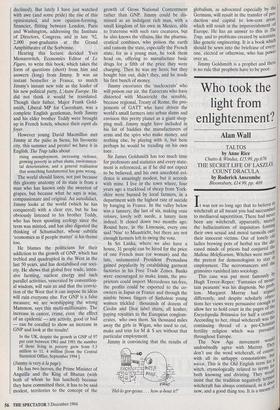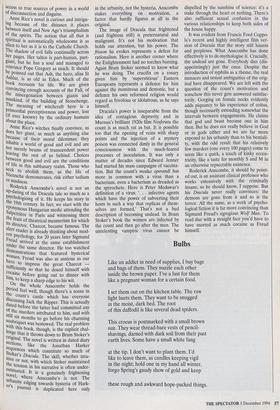Who took the light from enlightenment?
Alan Wall
.00
It was not so long ago that to believe to witchcraft at all meant you had succumbed to mediaeval superstition. There had never been any witchcraft, apparently, merelY the hallucinations of inquisitors foisting their own sexual and moral turmoils on°, their innocent victims. Out of lonely °I' ladies brewing pots of herbal tea the dis" eased minds of priests had conjured dr Malleus Meleficarum. Witches were mere,'Y the pretext for demonologists to stay 111 employment. The necromancers and the grimoires vanished into sociology. This case was put most famously 13Y Hugh Trevor-Roper: 'Fantasies of mot& tam n peasants' was his diagnosis. No prob..; lem. Margaret Murray had argue differently, and despite scholarly oblee- tions her views were persuasive enough t° allow her to hold court in the pages of the Encyclopedia Brittanica for half a centurY. According to her, ritual witchcraft was the continuing thread of a pre-Christial! fertility religion which was prevalen' throughout Europe. al The New Age movement w,,, undoubtedly agree with Murray. don't use the word witchcraft, of co11t5'; with all its unhappy connotations, btla wicca. This is the Old English term Oti. 1 witch, etymologically related to terms 190 both knowing and divining. They vottpd insist that the tradition negatively terill'es witchcraft has always continued, as it d°of now, and a good thing too. It is a meals access to true sources of power in a world of disconnection and disguise. Anne Rice's novel is curious and intrigu- ing because of the distance it places between itself and New Age's triumphalism of the spirits. The notion that all that is Spiritual is automatically wholesome is as alien to her as it is to the Catholic Church. The shadow of evil falls continually across her pages. Her taltos is part-human, part- giant, but he has a soul and managed to convince Pope Gregory as much. It should be pointed out that Ash, the hero, alias St Ashlar, is as old as Eden. Much of the book recounts his life. We are given convincing enough accounts of the Fall, of the miscegenation between giants and mankind, of the building of Stonehenge. The meaning of witchcraft here is a primordial perceptiveness and power, lost (if ever known) by the ordinary humans about the place. Anne Rice's witches finally convince, as does her giant, as much as anything else b. ecause of their moral dilemmas; they inhabit a world of good and evil and are not merely beams of transcendent power leaving the rest of us behind. Choices between good and evil are the conditions of life in this sublunary realm. Those who seek to abolish them, as the life of Nietzsche demonstrates, risk either tedium or madness. Roderick Anscombe's novel is not an up-dating of the Dracula tale so much as a PsYehologising of it. He keeps his story in the 19th century. In fact, we start with the eponymous Hungarian medic attending the Salpetriere in Paris and witnessing there the feats of theatrical mesmerism for which its director, Charcot, became famous. The alert reader is already thinking about mod- em psychology, for 20 years later Sigmund Preud arrived at the same establishment under the same director. He too watched demonstrations that featured hysterical oillen. Freud was also as anxious as our hero to impress the great Charcot sufficiently so that he dosed himself with cocaine before going out to dinner with him, to keep a sharp edge to his wit. On the whole Anscombe holds the period feel well, though there's a scene in the count's castle which has everyone discussing Jack the Ripper. This is actually dated before the latter had committed any of the murders attributed to him, and with Still six months to go before his charming soubriquet was bestowed. The real problem With this book, though, is the explicit chal- lenge that it throws down to Bram Stoker's original. The novel is written in dated diary sections, like the Jonathan Harker sequences which constitute so much of Stoker's Dracula. The skill, whether intu- itive or not, with which Stoker maintained the tension in his narrative is often under- estimated. It is a genuinely frightening novel, where Anscombe's is not. The urbanity edging towards hysteria of Hark- er's journal is duplicated here only in the urbanity, not the hysteria. Anscombe stakes everything on motivation, a factor that hardly figures at all in the original. The image of Dracula that frightened (and frightens still) is preternatural and malignant. It's not his motivation that holds our attention, but his power. The frisson he evokes represents a defeat for rationalism. Here is another corner where the Enlightenment had no torches burning. Again Bram Stoker seemed to know what he was doing. The crucifix on a rosary given him by 'superstitious' Eastern Europeans represents a defence for him against the monstrous and demonic, but a defence his own reformed religion would regard as frivolous or idolatrous, as he says himself.
Dracula's power is inseparable from the idea of contagious depravity and in Murnau's brilliant 1920s film Nosferatu the count is as much rat as bat. It is possible too that the opening of veins with sharp points and the injection of a mystery poison was connected dimly in the general consciousness with the much-feared processes of inoculation. It was only a matter of decades since Edward Jenner had started his mass campaigns of vaccina- tion. But the count's modus operandi has more in common with a virus than a bacterium, even a bacterium as dreaded as the spyrochete. Here is Peter Medawar's definition of a virus: `. . . infective agents which have the power of subverting their hosts in such a way that replicas of them- selves are formed.' That's not a bad description of becoming undead. In Bram Stoker's book the women are infected by the count and then go after the men. The unrelenting vampiric virus cannot be dispelled by the sunshine of science: it's a stake through the heart or nothing. There's also sufficient sexual confusion in the various relationships to keep both sides of the house happy.
It was evident from Francis Ford Coppo- la's recent and highly intelligent film ver- sion of Dracula that the story still haunts and perplexes. What Anscombe has done effectively is to de-mythologise it. Crucially, the undead are gone. Everybody dies (dis- appointingly) just the once. Despite the introduction of syphilis as a theme, the real menaces and sexual ambiguities of the orig- inal have disappeared. We are left with the question of the count's motivation and somehow this never gets answered satisfac- torily. Gorging on female necks evidently adds piquancy to his experience of coitus, though necessarily extending somewhat the intervals between engagements. He claims that god and beast become one in him then. But he does not really believe in God or in gods either and we are far more exposed to his urbanity than to his bestiali- ty, with the odd result that his relatively few murders (one every 100 pages) come to seem like a quirk, a touch of kinky eccen- tricity, like a taste for monthly S and M in an otherwise repsectable existence.
Roderick Anscombe, it should be point- ed out, is an assistant clinical professor who works extensively with the criminally insane, so he should know, I suppose. But his Dracula never really convinces: the demons are gone from it and so is the terror. All the same, as a work of psycho- logical fiction it is far more convincing than Sigmund Freud's egregious Wolf Man. To read that with a straight face you'd have to have snorted as much cocaine as Freud himself.











































































 Previous page
Previous page